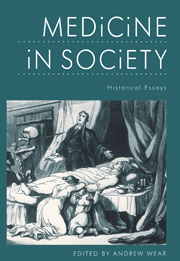Book contents
- Frontmatter
- Contents
- List of contributors
- Introduction
- Healers in the medical market place towards a social history of Graeco-Roman medicine
- Medicine and society in medieval Europe, 500-1500
- The patient in England, c. 1660–c. 1800
- Making sense of health and the environment in early modern England
- Medicine in the age of Enlightenment
- The rise of the modern hospital in Britain
- Medical practitioners 1750–1850 and the period of medical reform in Britain
- Public health, preventive medicine and professionalization: England and America in the nineteenth century
- Madness and its institutions
- From infectious to chronic diseases: changing patterns of sickness in the nineteenth and twentieth centuries
- Providers, ‘consumers’, the state and the delivery of health-care services in twentieth-century Britain
- The implications of increased life expectancy for family and social life
- Index
From infectious to chronic diseases: changing patterns of sickness in the nineteenth and twentieth centuries
Published online by Cambridge University Press: 13 January 2010
- Frontmatter
- Contents
- List of contributors
- Introduction
- Healers in the medical market place towards a social history of Graeco-Roman medicine
- Medicine and society in medieval Europe, 500-1500
- The patient in England, c. 1660–c. 1800
- Making sense of health and the environment in early modern England
- Medicine in the age of Enlightenment
- The rise of the modern hospital in Britain
- Medical practitioners 1750–1850 and the period of medical reform in Britain
- Public health, preventive medicine and professionalization: England and America in the nineteenth century
- Madness and its institutions
- From infectious to chronic diseases: changing patterns of sickness in the nineteenth and twentieth centuries
- Providers, ‘consumers’, the state and the delivery of health-care services in twentieth-century Britain
- The implications of increased life expectancy for family and social life
- Index
Summary
The relationship between the rise of modern medicine and the incidence of disease is controversial. It might be expected that the greater a society's investment in medical research and health care, the less disease there would occur. But while it is possible to target certain problems for solution, a multiplicity of factors produce overall improvements in health, and it must be appreciated that medicine, disease and society are not constant and uniform categories. The history of medicine shows that relations between medical practitioners, medical institutions, patients' expectations and diseases have been constantly changing. Calculating the costs of medical services, and the extent of sickness in past societies are immensely complex tasks. Another way of perceiving the relationship between the advent of modern scientific medical services and disease is to see not so much a diminishing quantity of disease, but a change in the quality – i.e. in the types and virulence – of diseases. Demographers often refer to an ‘ epidemiological transition ’ from pre-industrial patterns of epidemic infectious diseases to a modern pattern of deaths from chronic degenerative diseases. This raises the question whether morbidity and mortality patterns have fundamentally differed before and after industrialization, or whether only changes in perceptions and managing diseases have taken place.
Coupled with the rapid and substantial decline in infant mortality, the increased registered incidence of heart disease and cancers (the ills of middle and old age) has been an outstanding feature of industrial societies during the twentieth century.
- Type
- Chapter
- Information
- Medicine in SocietyHistorical Essays, pp. 303 - 316Publisher: Cambridge University PressPrint publication year: 1992
- 7
- Cited by

